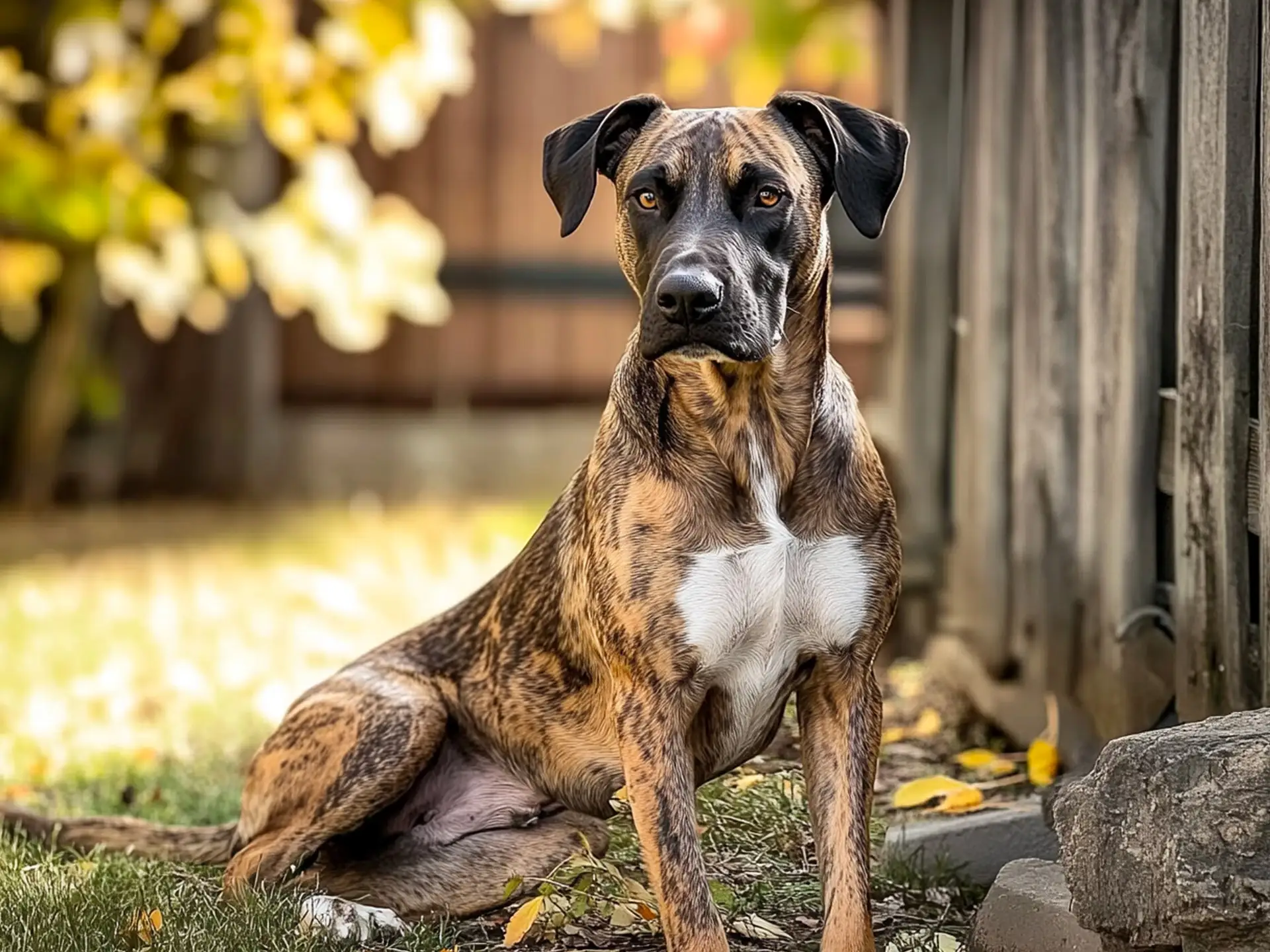Mountain Cur Dog Breed Info & Overview
Did you know the Mountain Cur once accompanied early American settlers on rugged frontiers? Revered for their strong hunting instincts and loyal nature, they bring both grit and devotion to the table. Active homes that crave outdoor pursuits often find them the perfect match, thanks to their tireless spirit and unwavering commitment to their family’s well-being.
Characteristics
Pictures
Breed History
Tracing its roots to the American frontier, the Mountain Cur likely descended from European stock brought over by settlers who relied on their dogs for survival. This sturdy canine earned its keep by hunting small game and guarding homesteads. Over time, breeders prized the Cur’s work ethic and versatility, making it a reliable partner in fields and forests alike.
As pioneers moved deeper into the Appalachian Mountains, they needed dogs with resilience and sharp instincts. The Mountain Cur fit that role perfectly, expertly tracking raccoons or squirrels, and standing guard when needed. They became essential not just for hunting but also for patrolling farmland. With each new generation, their reputation as an all-around working dog solidified in rural communities.
Eventually recognized for their unique qualities, the Mountain Cur was formalized by enthusiasts seeking to preserve its heritage. Although not as widely known as some medium dog breeds, it remains treasured among hunters and outdoorsy folk. The breed’s enduring legacy is rooted in its pioneer spirit—an attribute that continues to shine through in modern-day Cur families.
Temperament, Personality
Many owners describe the Mountain Cur as fearless yet warmhearted. This breed is known for its sharp protective instincts, often acting as a vigilant guardian. While it may be reserved around strangers, especially on first encounter, it quickly bonds with family members and those who respect its personal space.
Children typically adore this loyal companion, but early socialization is crucial for the best results. Introductions to kids, other pets, and new people can help the Cur adapt to different environments. Because of their strong prey drive, it’s wise to supervise them around smaller animals until you’re certain everyone gets along.
Though the Mountain Cur thrives in an active home, it also displays a gentle side when bonding with its family. Owners often recount delightful anecdotes of Curs leaning in for affection after a long day’s work. Their mental sharpness and eagerness to please make them a well-rounded companion for experienced dog enthusiasts and devoted families alike.
Physical Characteristics
At first glance, the Mountain Cur boasts a muscular build, hinting at its working heritage. The body is sturdy but agile, enabling quick pivots during hunts and long treks in challenging terrain. There’s an undeniable sense of athleticism in its strong limbs and balanced stance.
Coat textures vary, but most Curs sport a short, dense coat designed for practicality. Common colors include brindle, black, and yellow, with white markings sometimes appearing on the chest or feet. The coat’s thickness offers protection against underbrush and rough conditions, reflecting the breed’s frontier origins.
One of the breed’s most distinguishing features is its alert expression. The eyes convey intelligence and focus, a hint at how intently the Mountain Cur works when on a scent. Another recognizable trait is the ear set—medium-length and usually dropped—which helps funnel sounds of nearby prey or potential threats in the wilderness.
Health Issues
Although rugged and generally healthy, the Mountain Cur can be prone to common canine issues like hip dysplasia. Regular vet checks and maintaining a healthy weight can help reduce stress on joints. Joint supplements may be recommended as they age, providing extra support for this active breed.
Eye conditions, including certain genetic predispositions, occasionally appear in the breed. Routine screenings can catch early signs of cataracts or retinal issues. Discuss with your veterinarian the best preventive measures, as some lines have more predispositions than others. Ensuring responsible breeding practices remains key to mitigating inherited ailments.
Ear infections can arise due to their floppy ears trapping moisture, especially after outdoor adventures. Cleaning their ears regularly with a vet-approved solution helps ward off bacteria. By staying vigilant about potential health issues and scheduling annual vet visits, Mountain Cur owners can keep their hardy companions in prime condition for years to come.
Grooming Needs
Mountain Cur coats are relatively low-maintenance, but a quick weekly brushing can keep shedding in check. Their short, dense coat benefits from occasional grooming to remove dead fur and dirt, particularly after hunting excursions. This simple routine ensures the coat stays shiny and free of tangles.
Bathing should be done as needed—usually every few months or after a particularly messy day in the field. Too many baths can strip the natural oils that keep their coat healthy. A mild, dog-specific shampoo is best, preserving skin health while leaving them fresh for home life.
Pay special attention to paw pads and nails, especially if your Cur roams rough terrain. Trimming nails regularly prevents cracks or overgrowth. Checking paws for debris or minor injuries helps you catch small problems before they become big ones. Overall, this breed’s grooming is moderate, fitting nicely into a busy yet active household.
Exercise Requirements
With high energy levels, the Mountain Cur craves daily exercise—think vigorous walks, hikes, or extended play sessions in a spacious yard. Idle time often leads to pent-up energy and mischievous behavior. Mental stimulation is just as important, so puzzle toys or scent games can keep them engaged.
Because of their hunting heritage, they benefit from activities that tap into their instincts. Tracking exercises or a friendly game of hide-and-seek with treats can do wonders. If possible, let them explore nature trails or fields where they can sniff and investigate, satisfying their natural curiosity.
Failing to meet these exercise demands can result in restlessness or even destructive behaviors, like chewing on furniture. A structured routine is key—stick to consistent walks and playful tasks that challenge their keen senses. Overall, the Mountain Cur thrives when given ample opportunities to move and think, making an active owner a must.
Training Tips
Start with consistency and patience. The Mountain Cur is smart, but it can also be strong-willed, especially when a scent or excitement catches its attention. Firm, positive reinforcement methods yield the best outcomes, combining praise and treats to keep them motivated.
Early socialization is vital for teaching manners around other animals and people. Group obedience classes, particularly those tailored to working dog breeds, can help refine their focus. Keeping sessions short yet engaging helps retain their interest, as too much repetition may lead to boredom.
Mountain Curs generally respond quickly to commands when training is interactive. Agility courses or advanced nose-work can tap into their natural skills, offering both mental and physical challenges. If training stalls, maintain a calm demeanor—harsh tactics can erode trust. With consistency, you’ll soon see the Cur’s loyalty and reliability shine.
Nutrition, Diet
Because Mountain Curs are highly active, they need a protein-rich diet that supports muscle development and sustained energy. Look for dog food specifically formulated for working or athletic breeds, often containing higher levels of protein (around 26% or more) and moderate fats. Aim to include healthy carbs like sweet potatoes for slow-release energy.
A typical adult Cur weighing about 50–60 pounds might require approximately 2.5 to 3 cups of quality dry kibble daily, divided into two meals. For heavier Curs closer to 70–75 pounds, increase slightly to around 3.5 cups. Always adjust based on activity level—more strenuous days may justify a little extra fuel, while downtime calls for moderation.
Because these dogs can spend hours on the trail, consider adding supplements like fish oil for joint health and overall vitality. Fresh fruits and vegetables (like carrots, broccoli, or apples) can serve as low-calorie snacks. Keep an eye on weight gain, and consult a veterinarian to tweak meal plans if your Mountain Cur’s exercise regimen changes dramatically.
Adoption, Breeders
If you’re considering a Mountain Cur, explore adoption first. Breed-specific rescues sometimes have wonderful adult dogs waiting for homes, and fostering can help assess compatibility. Look for well-reviewed rescue organizations focused on working or hunting breeds to match you with a Cur that aligns with your lifestyle.
For those leaning toward a breeder, prioritize ethical breeders who health-test their stock to avoid hereditary issues. Ask about lineage, working ability, and socialization practices. Mountain Cur Breeders Association provides details about reputable breeders, while Petfinder lists adoptable dogs near you. Both can guide you toward trusted resources.
Remember, you’re choosing a companion that will likely be with you for a decade or more. Seek out breeders or rescues that value the Mountain Cur’s working heritage, ensuring your puppy or adult dog has a stable temperament. Always research thoroughly, meet the breeder or rescue in person, and ask plenty of questions before making any commitments.
Family Pet?
With loyalty and courage in abundance, the Mountain Cur is often a great fit for outdoorsy families. Their strong protective streak can provide peace of mind, as they’re quick to alert you of anything amiss. However, consistent boundaries and training are needed to ensure they interact confidently with guests and children alike.
In a home with kids, this breed shines when playtime is structured. Older children can help train or exercise the Cur, building a meaningful bond. Younger children benefit from supervised interactions until everyone learns proper handling. Patience, gentle introductions, and plenty of positive reinforcement make family life smoother.
Thanks to their affectionate side, Mountain Curs often become a steadfast part of the family unit. They do well when given clear “jobs,” whether that’s patrolling the yard or performing simple commands. If you’re committed to consistent training and appreciate a dog that can keep up with an active clan, the Cur is ready to step in as your loyal partner.
Right For You?
If your lifestyle includes hiking, farm work, or extended weekend outings, the Mountain Cur might fit seamlessly into your routine. This dog thrives on adventure and is well-suited for environments where it can burn off energy. If you prefer calm evenings indoors and minimal exercise routines, you may find yourself dealing with restless behaviors.
Owners who appreciate a protective companion will find the Cur’s watchful nature reassuring. However, they do need clear leadership to prevent over-guarding. City dwellers can manage if they provide ample outings and mental stimulation, but a suburban or rural setup is ideal. Evaluate your commitment to training, exercise, and socialization before welcoming one into your life.
By doing your homework and meeting this breed’s demands, you’ll likely discover a loyal partner eager to join you on every escapade. Their unwavering devotion, combined with a strong work drive, appeals to those seeking more than just a couch buddy. For the right person, the Mountain Cur can bring years of companionship laced with excitement and a dash of frontier spirit.
Conclusion
If you’re looking for a determined, outdoorsy partner with a strong sense of loyalty, the Mountain Cur could be your ideal fit. This breed thrives in active families and rewards patient, consistent training with unwavering devotion. Whether you’re out on a hunting trip or relaxing after a hike, expect your Cur to stay close by, ready for the next big adventure together.
FAQs
-
What makes the Mountain Cur different from other Cur breeds?
The Mountain Cur stands out due to its strong treeing instincts, muscular build, and high endurance. Unlike Black Mouth Curs or Catahoula Curs, Mountain Curs were bred specifically for hunting squirrels, raccoons, and even wild boar, excelling in rugged, mountainous terrain.
-
Do Mountain Curs have webbed feet?
Yes, some Mountain Curs have slightly webbed feet, which help them navigate muddy or rocky terrain and can assist in swimming. While not as pronounced as water breeds, their sturdy paws provide excellent grip, making them natural climbers and versatile working dogs.
-
Are Mountain Curs naturally protective?
Absolutely. Mountain Curs have strong protective instincts and are often territorial. They were bred as farm guardians and hunting companions, so they naturally watch over their home and family. With proper training, they make loyal but discerning watchdogs.
-
Can a Mountain Cur live in an apartment?
A Mountain Cur is not ideal for apartment living due to its high energy and need for open space. Without daily vigorous exercise, they can become restless or destructive. However, with sufficient outdoor time, training, and mental stimulation, they can adapt to a structured lifestyle.
-
Do Mountain Curs have a strong prey drive?
Yes! Mountain Curs have an intense prey drive, especially towards small animals like squirrels, rabbits, and raccoons. Their natural treeing ability makes them excellent hunting dogs, but they require early socialization if living with smaller pets like cats.
Breed Ratings
The Mountain Cur is bright and alert, ready to learn new tasks, though it may be strong-willed at times.
Enjoys games and family interactions but still maintains a focused, working demeanor.
Highly active, thrives with challenging physical activities and plenty of outdoor time.
Short coat sheds moderately, requiring routine brushing to minimize loose hair.
Bred for hunting, so expect a strong instinct to chase small animals if not well-managed.
Short coat makes upkeep relatively simple; just maintain weekly brushing and occasional baths.
Intelligent but can be stubborn; positive reinforcement and consistency are key.
Prefers company and mental stimulation; long stretches alone may lead to destructive behavior.
Vocal during hunts or when alerting, but not overly noisy at home without cause.
Generally minimal drool, but can increase if excited or after strenuous activity.
Typically gets along with other dogs if socialized early, but can display dominance.
Sturdy breed with a few known issues; regular checkups help maintain overall wellness.















